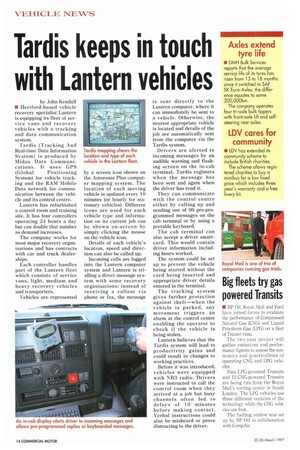Tardis keeps in touch with Lantern vehicles
Page 16

If you've noticed an error in this article please click here to report it so we can fix it.
by John Kendall • Hertford-based vehicle recovery specialist Lantern is equipping its fleet of service vans and recovery vehicles with a tracking and data communication system.
Tardis (Tracking And Real-time Data Information System) is produced by Midas Data Communications. It uses GPS (Global Positioning System) for vehicle tracking and the RAM Mobile Data network for communication between the vehicle and its control centre.
Lantern has refurbished a control room and training site. It has four controllers operating 24 hours a day but can double that number as demand increases.
The company works for most major recovery organisations and has contracts with car and truck dealerships.
Each controller handles part of the Lantern fleet which consists of service vans, light, medium and heavy recovery vehicles and transporters.
Vehicles are represented by a screen icon shown on the Autoroute Plus computer mapping system. The location of each moving vehicle is updated every 10 minutes (or hourly for stationary vehicles). Different icons are used for each vehicle type and information on its current job can be shown on-screen by simply clicking the mouse on the vehicle icon.
Details of each vehicle's location, speed and direction can also be called up.
Incoming calls are logged into the Lantern computer system and Lantern is trailing a direct message system with some recovery organisations: instead of receiving a callout via phone or fax, the message is sent directly to the Lantern computer, where it can immediately be sent to a vehicle. Otherwise, the nearest appropriate vehicle is located and details of the job are automatically sent from the computer via the Tardis system.
Drivers are alerted to incoming messages by an audible warning and flashing screen on the in-cab terminal. Tardis registers when the message has been sent and again when the driver has read it.
They can communicate with the control centre either by calling up and sending one of 90 pre-programmed messages on the cab terminal or by using a portable keyboard.
The cab terminal can also accept a driver smartcard. This would contain driver information including hours worked.
The system could be set up to prevent the vehicle being started without the card being inserted and appropriate driver details entered in the terminal.
The tracking system gives further protection against theft—when the vehicle is parked, any movement triggers an alarm at the control centre enabling the operator to check if the vehicle is being stolen.
Lantern believes that the Tardis system will lead to productivity gains and could result in changes to working practices.
Before it was introduced, vehicles were equipped with NB3 radio. Drivers were instructed to call the control room when they arrived at a job but busy channels often led to delays of 10 minutes before making contact. Verbal instructions could also be misheard or prove distracting to the driver.
















































































































